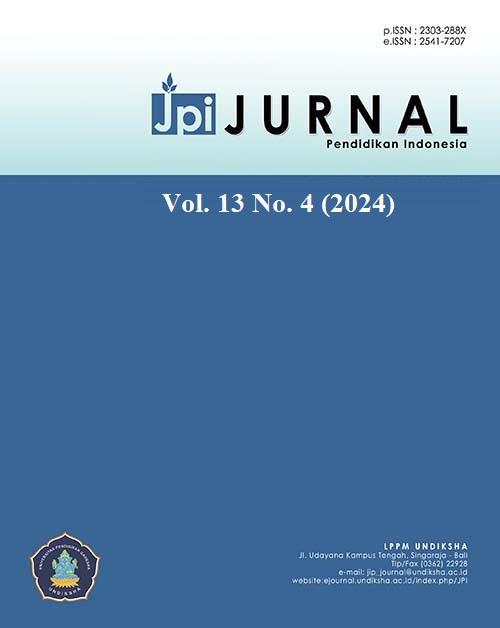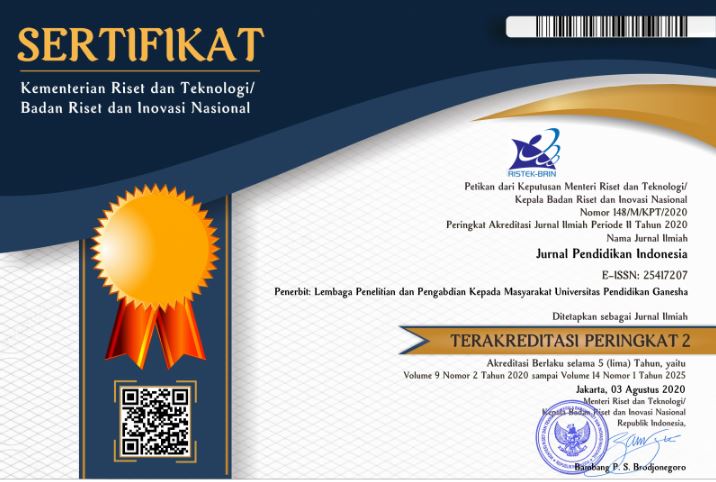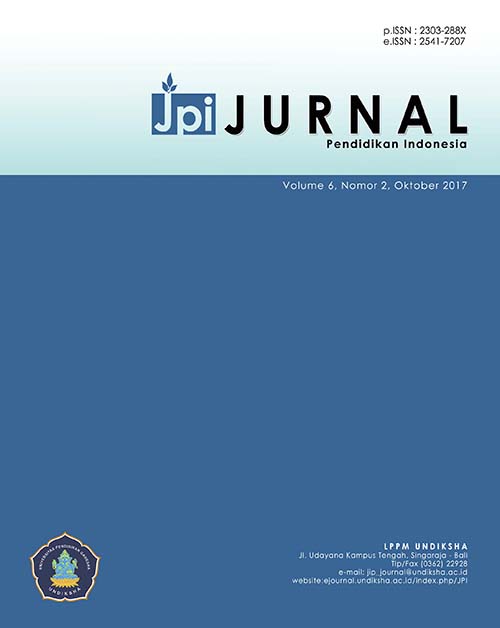Silent Reading Training Improves Reading Speed and Reading Comprehension
DOI:
https://doi.org/10.23887/jpiundiksha.v13i4.82886Kata Kunci:
silent reading, reading speed, reading comprehension, early age studentsAbstrak
The speed reading and reading comprehension abilities of junior high school students are still far from ideal criteria. There are still many students who do not understand reading quickly and well. The aim of this study was to examine the effect of fast and silent reading skills training on students' reading speed and achievement at an early age. This research also seeks to explore the effectiveness of training interventions and their potential for students based on gender. The research method used in this research is quasi-experimental. The participants involved in this research were 350 junior high school students in grades 1-3. The experimental group received speed reading skills training 15 times using Indonesian language books. The control group used the regular curriculum. The data analysis used is correlation analysis between variables based on sample data, data range, skewness and kurtosis. In addition, ANCOVA analysis was carried out to determine the impact of the intervention on fast reading skills silently through pre- and post-intervention score analysis. The results showed that students in the experimental group showed a higher reading speed than students in the control group. Students who received intervention showed a better level of reading effectiveness in the posttest phase compared to the reading ability of students in the control group. In terms of gender, male students show better reading speed than female students. However, in terms of reading comprehension level, male and female students showed similar improvements in the posttest phase.
Referensi
Alvarenga, P., Zucker, T. A., Tambyraja, S., & Justice, L. (2019). Contingency In Teacher-Child Emotional State Talk During Shared Book Reading In Early Childhood Classrooms. Early Education And Development, 31(8), 1187–1205. Https://Doi.Org/10.1080/10409289.2020.1722786.
Amendum, S. J., & Liebfreund, M. D. (2018). Situated Learning, Professional Development, And Early Reading Intervention: A Mixed Methods Study. Journal Of Educational Research, 112(3), 342–356. Https://Doi.Org/10.1080/00220671.2018.1523782.
Beucher, B., Arya, D., & Wang, C. (2020). Interactive Whiteboard (Iwb) Use During Student Collaborative Reading Practices: A Year-Long Comparison Of Instructional Approaches (Vol. 48, Issue 7, Pp. 779–794). Https://Doi.Org/10.1080/03004279.2019.1649292.
Bippert, K. (2020). Text Engagement & Reading Strategy Use: A Case Study Of Four Early Adolescent Students. Reading Psychology, 41(5), 434–460. Https://Doi.Org/10.1080/02702711.
Boardman, K. (2019). Where Are The Children’s Voices And Choices In Educational Settings’ Early Reading Policies? A Reflection On Early Reading Provision For Under-Threes. European Early Childhood Education Research Journal, 30(1), 131–146. Https://Doi.Org/10.1080/1350293x.2022.2026437.
Boardman, K. (2020). Too Young To Read’: Early Years Practitioners’ Perceptions Of Early Reading With Under-Threes. International Journal Of Early Years Education, 28(1), 81–96. Https://Doi.Org/10.1080/09669760.2019.1605886.
Boerma, I., Wilt, F., Bouwer, R., Schoot, M., & Veen, C. (2019). Mind Mapping During Interactive Book Reading In Early Childhood Classrooms: Does It Support Young Children’s Language Competence? Early Education And Development, 33(6), 1077–1093. Https://Doi.Org/10.1080/10409289.2021.
Bouck, E. C., Truckenmiller, A., Bone, E., & Flanagan, S. (2020). Comparing The Effectiveness Of Reading Modifications On Comprehension Accuracy And Reading Comprehension Rate. Preventing School Failure, 65(3), 194–205. Https://Doi.Org/10.1080/1045988x.2021.1875393.
Bulunuz, M., & Koç, D. (2017). The Evaluation Of Pre-Service Preschool Teachers’ Experiences And Views Regarding Integrated Guided Reading Practices. European Early Childhood Education Research Journal, 27(2), 208–220. Https://Doi.Org/10.1080/1350293x.2019.1579548.
Cabell, S. Q., Zucker, T. A., Decoster, J., Melo, C., Forston, L., & Hamre, B. (2020). Prekindergarten Interactive Book Reading Quality And Children’s Language And Literacy Development: Classroom Organization As A Moderator. Early Education And Development, 30(1), 1–18. Https://Doi.Org/10.1080/10409289.2018.1514845.
Gunnerud, H. L., Foldnes, N., & Melby-Lervåg, M. (2020). Levels Of Skills And Predictive Patterns Of Reading Comprehension In Bilingual Children With An Early Age Of Acquisition. Reading And Writing, 35(10), 2365–2387. Https://Doi.Org/10.1007/S11145-022-10286-2.
Hadianto, D., Damaianti, S., V., M., Y., & Sastromiharjo, A. (2021). Effectiveness Of Literacy Teaching Design Integrating Local Culture Discourse And Activities To Enhance Reading Skills. Cogent Education, 9(1), 34. Https://Doi.Org/10.1080/2331186x.2021.2016040.
Hagans, K. S., & Good, R. H. (2020). Decreasing Reading Differences In Children From Disadvantaged Backgrounds: The Effects Of An Early Literacy Intervention. Contemporary School Psychology, 17(1), 103–117. Https://Doi.Org/10.1007/Bf03340992.
Hayden, E., Hiebert, E. H., & Trainin, G. (2019). Patterns Of Silent Reading Rate And Comprehension As A Function Of Developmental Status, Genre, And Text Position. Reading Psychology, 40(8), 731–767. Https://Doi.Org/10.1080/02702711.2019.1673602.
Hayes, N., & Berthelsen, D. C. (2019). Longitudinal Profiles Of Shared Book Reading In Early Childhood And Children’s Academic Achievement In Year 3 Of School. School Effectiveness And School Improvement, 31(1), 31–49. Https://Doi.Org/10.1080/09243453.2019.1618347.
Hoel, T., & Jernes, M. (20 C.E.). Quality In Children’s Digital Picture Books: Seven Key Strands For Educational Reflections For Shared Dialogue-Based Reading In Early Childhood Settings. Early Years, 3(2), 1–15. Https://Doi.Org/10.1080/09575146.2023.2172552.
Hollowell, J., Belem, M., Swigart, T., Murray, J., & Hill, Z. (2017). Age-Related Patterns Of Early Childhood Development Practices Amongst Rural Families In Burkina Faso: Findings From A Nationwide Survey Of Mothers Of Children Aged 0-3 Years. Global Health Action, 13(1), 76. Https://Doi.Org/10.1080/16549716.2020.1772560.
Joseph, L., Ross, K., Xia, Q., Amspaugh, L. A., & Accurso, J. (2018). Reading Comprehension Instruction For Students With Intellectual Disabilities:A Systematic Literature Review. International Journal Of Disability, Development And Education, 70(3), 314–339. Https://Doi.Org/10.1080/1034912x.
Kamykowska, J., Łuniewska, M., Banasik-Jemielniak, N., Czaplewska, E., Kochańska, M., Krajewski, G., Maryniak, A., Wiejak, K., Krasowicz-Kupis, G., & Haman, E. (2020). Co-Occurrence And Cognitive Basis Of Low Language And Low Reading Skills In Children Speaking A Transparent Language. Reading And Writing, 0123456789(3), 98. Https://Doi.Org/10.1007/S11145-024-10537-4.
Kang, E. Y., & Shin, M. (2018). The Contributions Of Reading Fluency And Decoding To Reading Comprehension For Struggling Readers In Fourth Grade. Reading And Writing Quarterly, 35(3), 179–192. Https://Doi.Org/10.1080/10573569.2018.1521758.
Kim, Y. S. G., Little, C., Petscher, Y., & Vorstius, C. (2020). Developmental Trajectories Of Eye Movements In Oral And Silent Reading For Beginning Readers: A Longitudinal Investigation. Scientific Reports, 12(1), 1–14. Https://Doi.Org/10.1038/S41598-022-23420-5.
Kiuru, N., Delay, D., Laursen, B., Burk, W. J., Lerkkanen, M. K., Poikkeus, A. M., & Nurmi, J. E. (2019). Peer Selection And Influence On Children’s Reading Skills In Early Primary Grades: A Social Network Approach. Reading And Writing, 30(7), 1473–1500. Https://Doi.Org/10.1007/S11145-017.
Koops, L. H., & Tate, K. (2018). A Framework For Considering Teacher-Child Musical Interactions In The Early Childhood Classroom. Early Child Development And Care, 191(12), 1956–1971. Https://Doi.Org/10.1080/03004430.2020.1862820.
Korinth, S. P., & Fiebach, C. J. (2020). Improving Silent Reading Performance Through Feedback On Eye Movements: A Feasibility Study. Scientific Studies Of Reading, 22(4), 289–307. Https://Doi.Org/10.1080/10888438.2018.1439036.
Kuswandi, D., & Fadhli, M. (2018). The Effects Of Gamification Method And Cognitive Style On Children’s Early Reading Ability. Cogent Education, 9(1), 56. Https://Doi.Org/10.1080/2331186x.
Li, G., & Yang, L. (2024). A Multilevel Analysis Of Asian Immigrant Children’s Reading Achievement In The Early Years: Evidence From The Ecls-K Data. Frontiers Of Education In China, 10(1), 110–131. Https://Doi.Org/10.3868/S110-004-0015-0007-5.
Lott, L. A., Schneck, M. E., Haegerstrom-Portnoy, G., Hewlett, S., Stepien-Bernabe, N., Gauer, B. M., Zaidi, A., Fu, A. D., & Brabyn, J. A. (2020). Simple Vision Function Tests That Distinguish Eyes With Early To Intermediate Age-Related Macular Degeneration. Ophthalmic Epidemiology, 28(2), 93–104. Https://Doi.Org/10.1080/09286586.2020.1793371.
Mcnally, S., Leech, K. A., Corriveau, K. H., & Daly, M. (2019). Indirect Effects Of Early Shared Reading And Access To Books On Reading Vocabulary In Middle Childhood. Scientific Studies Of Reading, 28(1), 42–59. Https://Doi.Org/10.1080/10888438.2023.2220846.
Mulyati, Y., & Hadianto, D. (2019). Relation Between Behavioural Problems And Reading Skills In Gender Contexts: Forecasting Longitudinal Data From Kindergarten To Fifth Grade. Journal Of Educational And Social Research, 12(4), 120–130. Https://Doi.Org/10.36941/Jesr-2022-0101.
Okyay, O., & Kandir, A. (2017). The Impact Of Interactive Storybook Reading Programme On Scientific Vocabulary Acquisition By Children. Early Child Development And Care, 191(13), 2067–2077. Https://Doi.Org/10.1080/03004430.2019.1685508.
Paige, D. D., Smith, G. S., Rasinski, T. V, Rupley, W. H., Magpuri-Lavell, T., & Nichols, W. D. (2020). A Path Analytic Model Linking Foundational Skills To Grade 3 State Reading Achievement. Journal Of Educational Research, 112(1), 110–120. Https://Doi.Org/10.1080/00220671.2018.1445609.
Piasta, S. B., Groom, L. J., Khan, K. S., Skibbe, L. E., & Bowles, R. P. (2020). Young Children’s Narrative Skill: Concurrent And Predictive Associations With Emergent Literacy And Early Word Reading Skills. Reading And Writing, 31(7), 1479–1498. Https://Doi.Org/10.1007/S11145-018-9844-7.
Price-Mohr, R., & Price, C. (2020). Gender Differences In Early Reading Strategies: A Comparison Of Synthetic Phonics Only With A Mixed Approach To Teaching Reading To 4–5 Year-Old Children. Early Childhood Education Journal, 45(5), 613–620. Https://Doi.Org/10.1007/S10643-016-0813.
Reikerås, E., & Dahle, A. E. (2020). Relations Between Reading Skill Level In Fifth Grade And Functional Language Skills At Toddler Age. European Early Childhood Education Research Journal, 30(6), 961–974. Https://Doi.Org/10.1080/1350293x.2022.2046831.
Satriana, M., Heriansyah, M., & Maghfirah, F. (2020). The Use Of Shared Reading Books In Indonesian Early Childhood. Education, 50(6), 777–788. Https://Doi.Org/10.1080/03004279.2021.1912134.
Vaknin-Nusbaum, V., Nevo, E., & Gilat-Yihyie, S. (2021). Language And Print Concepts Achievement Among Children With Low And High Reading Motivation. Reading Psychology, 42(7), 730–757. Https://Doi.Org/10.1080/02702711.2021.1912972.
Villanueva, J. M. (2019). Language Profile, Metacognitive Reading Strategies, And Reading Comprehension Performance Among College Students. Cogent Education, 9(1), 76. Https://Doi.Org/10.1080/2331186x.2022.2061683.
Wilt, F., Boerma, I., Oers, B., & Veen, C. (2019). The Effect Of Three Interactive Reading Approaches On Language Ability: An Exploratory Study In Early Childhood Education. European Early Childhood Education Research Journal, 27(4), 566–580. Https://Doi.Org/10.1080/1350293x.2019.1634242.
Wissinger, D. R., Truckenmiller, A. J., Konek, A. E., & Ciullo, S. (2018). The Validity Of Two Tests Of Silent Reading Fluency: A Meta-Analytic Review. Reading And Writing Quarterly, 40(2), 118–134. Https://Doi.Org/10.1080/10573569.2023.2175340.
Zhang, C., Bingham, G. E., Zhang, X., Schmitt, S. A., Purpura, D. J., & Yang, F. (2022). Untangling Chinese Preschoolers’ Early Writing Development: Associations Among Early Reading, Executive Functioning, And Early Writing Skills. Reading And Writing, 33(Ue 5)), 65. Https://Doi.Org/10.1007/S11145-019-10006-3.
Unduhan
Diterbitkan
Terbitan
Bagian
Lisensi
Hak Cipta (c) 2024 Herdiana Herdiana, Sirojul Munir

Artikel ini berlisensiCreative Commons Attribution-ShareAlike 4.0 International License.
Authors who publish with the Jurnal Pendidikan Indnesia agree to the following terms:
- Authors retain copyright and grant the journal the right of first publication with the work simultaneously licensed under a Creative Commons Attribution License (CC BY-SA 4.0) that allows others to share the work with an acknowledgment of the work's authorship and initial publication in this journal.
- Authors are able to enter into separate, additional contractual arrangements for the non-exclusive distribution of the journal's published version of the work (e.g., post it to an institutional repository or publish it in a book), with an acknowledgment of its initial publication in this journal.
- Authors are permitted and encouraged to post their work online (e.g., in institutional repositories or on their website) prior to and during the submission process, as it can lead to productive exchanges, as well as earlier and greater citation of published work. (See The Effect of Open Access)








